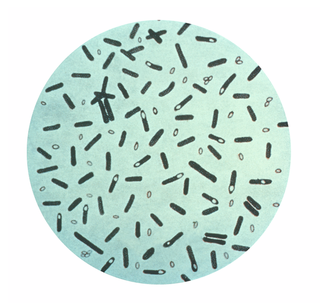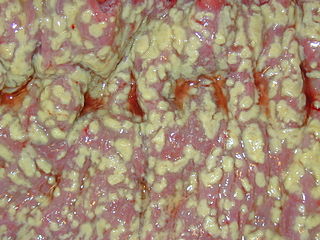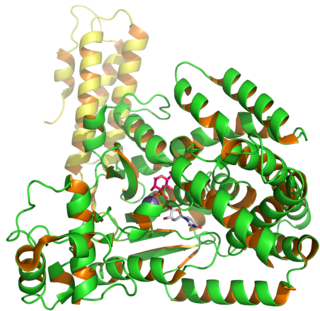
Clostridium botulinum is a gram-positive, rod-shaped, anaerobic, spore-forming, motile bacterium with the ability to produce botulinum toxin, which is a neurotoxin.

Clostridium is a genus of anaerobic, Gram-positive bacteria. Species of Clostridium inhabit soils and the intestinal tract of animals, including humans. This genus includes several significant human pathogens, including the causative agents of botulism and tetanus. It also formerly included an important cause of diarrhea, Clostridioides difficile, which was reclassified into the Clostridioides genus in 2016.

Clostridioides difficile infection, also known as Clostridium difficile infection, is a symptomatic infection due to the spore-forming bacterium Clostridioides difficile. Symptoms include watery diarrhea, fever, nausea, and abdominal pain. It makes up about 20% of cases of antibiotic-associated diarrhea. Antibiotics can contribute to detrimental changes in gut microbiota; specifically, they decrease short-chain fatty acid absorption which results in osmotic, or watery, diarrhea. Complications may include pseudomembranous colitis, toxic megacolon, perforation of the colon, and sepsis.

Clostridium perfringens is a Gram-positive, bacillus (rod-shaped), anaerobic, spore-forming pathogenic bacterium of the genus Clostridium. C. perfringens is ever-present in nature and can be found as a normal component of decaying vegetation, marine sediment, the intestinal tract of humans and other vertebrates, insects, and soil. It has the shortest reported generation time of any organism at 6.3 minutes in thioglycolate medium.

Psychrophiles or cryophiles are extremophilic organisms that are capable of growth and reproduction in low temperatures, ranging from −20 °C (−4 °F) to 20 °C (68 °F). They are found in places that are permanently cold, such as the polar regions and the deep sea. They can be contrasted with thermophiles, which are organisms that thrive at unusually high temperatures, and mesophiles at intermediate temperatures. Psychrophile is Greek for 'cold-loving', from Ancient Greek ψυχρός (psukhrós) 'cold, frozen'.

Lacticaseibacillus casei is an organism that belongs to the largest genus in the family Lactobacillaceae, a lactic acid bacteria (LAB), that was previously classified as Lactobacillus casei. This bacteria has been identified as facultatively anaerobic or microaerophilic, acid-tolerant, non-spore-forming bacteria.

Fecal microbiota transplant (FMT), also known as a stool transplant, is the process of transferring fecal bacteria and other microbes from a healthy individual into another individual. FMT is an effective treatment for Clostridioides difficile infection (CDI). For recurrent CDI, FMT is more effective than vancomycin alone, and may improve the outcome after the first index infection.

Clostridium perfringens alpha toxin is a toxin produced by the bacterium Clostridium perfringens and is responsible for gas gangrene and myonecrosis in infected tissues. The toxin also possesses hemolytic activity.

Butyryl-CoA is an organic coenzyme A-containing derivative of butyric acid. It is a natural product found in many biological pathways, such as fatty acid metabolism, fermentation, and 4-aminobutanoate (GABA) degradation. It mostly participates as an intermediate, a precursor to and converted from crotonyl-CoA. This interconversion is mediated by butyryl-CoA dehydrogenase.

Clostridioides difficile toxin B (TcdB) is a cytotoxin produced by the bacteria Clostridioides difficile. It is one of two major kinds of toxins produced by C. difficile, the other being a related enterotoxin. Both are very potent and lethal.

Fidaxomicin, sold under the brand name Dificid among others, is the first member of a class of narrow spectrum macrocyclic antibiotic drugs called tiacumicins. It is a fermentation product obtained from the actinomycete Dactylosporangium aurantiacum subspecies hamdenesis. Fidaxomicin is minimally absorbed into the bloodstream when taken orally, is bactericidal, and selectively eradicates pathogenic Clostridioides difficile with relatively little disruption to the multiple species of bacteria that make up the normal, healthy intestinal microbiota. The maintenance of normal physiological conditions in the colon may reduce the probability of recurrence of Clostridioides difficile infection.
Clostridium chauvoei is an anaerobic, motile, Gram-positive bacterium. It is a soil-borne pathogen that can cause blackleg in cattle and sheep. It is named after Auguste Chauveau, a French bacteriologist and veterinarian.
Thermoanaerobacterium thermosaccharolyticum, previously known as Clostridium thermosaccharolyticum, is a bacterium belonging to the Bacillota. It is an anaerobic, motile, gram-positive bacterium.

Clostridioides difficile is a bacterium known for causing serious diarrheal infections, and may also cause colon cancer. It is known also as C. difficile, or C. diff, and is a Gram-positive species of spore-forming bacteria. Clostridioides spp. are anaerobic, motile bacteria, ubiquitous in nature and especially prevalent in soil. Its vegetative cells are rod-shaped, pleomorphic, and occur in pairs or short chains. Under the microscope, they appear as long, irregular cells with a bulge at their terminal ends. Under Gram staining, C. difficile cells are Gram-positive and show optimum growth on blood agar at human body temperatures in the absence of oxygen. C. difficile is catalase- and superoxide dismutase-negative, and produces up to three types of toxins: enterotoxin A, cytotoxin B and Clostridioides difficile transferase. Under stress conditions, the bacteria produce spores that are able to tolerate extreme conditions that the active bacteria cannot tolerate.
Clostridium algoriphilum is a psychrophilic, Gram-positive, strict anaerobic, spore-forming and motile bacterium from the genus Clostridium which has been isolated from an over-cooled brine from the permafrost in Kolyma Lowland in Russia.
Enterocloster asparagiformis, formerly Clostridium asparagiforme, is a Gram-positive, obligately anaerobic and rod-shaped bacterium. It was isolated from human faeces in Germany.
Clostridium bowmanii is a psychrophilic, Gram-positive, anaerobic and spore-forming bacterium from the genus Clostridium.
Lacrimispora celerecrescens is a bacterium from the genus Lacrimispora.
Clostridium frigoris is a Gram-positive, rod-shaped, and spore-forming bacterium from the genus Clostridium. It is a psychrophile, with optimal growth conditions at 5–7 °C.
Clostridium lacusfryxellense is a psychrophilic, Gram-positive, spore-forming and anaerobic bacterium from the genus Clostridium which has been isolated from a microbial mat from Lake Fryxell in Antarctica.










